[Editor’s note: This blog post originally appeared in Vita Brevis on 3 October 2016.]

One day, when searching through the town records of New Haven, Connecticut, I was struck by one of the entries. The writing appeared like nothing I had ever seen before. After asking others for their thoughts, we found that none of us had ever seen this form of writing before. After some research, I discovered that what I had found was notation written in Taylor Shorthand, a system of writing developed by Samuel Taylor in 1786, the first system of shorthand writing to be widely used across the English-speaking world.[1]
Shorthand has long been used as a method of notation, often when time or efficiency is imperative, and as a result, it often appears in court documents and meeting minutes. The first known shorthand system was developed by Roman Marcus Tillius Tiro c. 60 B.C. Tiro’s shorthand employed abbreviations which are still in use today including ‘et’ for the word and as well as ‘viz,’ meaning namely.[2]
Other systems of shorthand gained popularity starting in the eighteenth century. One such system was Universal English Shorthand, developed by John Byrom.[3] The purpose of shorthand systems was made clear in the preface to The Universal English Shorthand (published in 1767), presenting Byrom’s system. This work stated that “Mr. Byrom’s method of short-hand may be termed, the art of expressing all the words and phrases of the English tongue by a character, which is perfectly regular and beautiful, and, as we conceive, the shortest possible.”[4]
In Taylor Shorthand, vowels are omitted from words except when they begin or end a word, in which case they are represented by a single dot.
The system developed by Samuel Taylor utilizes characters as shortened forms of letters and words, and was applied in the recording of many records and court documents upon its development in the late eighteenth century. In Taylor Shorthand, vowels are omitted from words except when they begin or end a word, in which case they are represented by a single dot.[5] In many cases, symbols which represent a single letter are also used as an abbreviation for common words in stenography (see table above).[6] The style of writing also contains other unique methods which were generally used to save time. For example, when two consonants come together with the removal of a vowel, the symbol for that consonant is written once in a larger size.[7]
Since the publication of Taylor’s shorthand method in 1786, other forms of shorthand have also come into popular usage, including Pitman’s Shorthand, which was developed and published by Sir Isaac Pitman in 1837. Pitman’s Shorthand was unique in that silent and voiced sounds were represented by lines differing in thickness, requiring the writer to use a proper writing implement to successfully convey the correct sounds or syllables.[8]
The rise of typewriters, and more recently, personal computers, has led to a significant drop in the importance of shorthand notation. Despite this, a knowledge of these writing systems and their application in the transcription of records in past centuries remains important to genealogists.
Notes
[1] Sir Isaac Pitman, A History of Shorthand (1891), 48–55.
[2] David A. King, The Ciphers of the Monks: A Forgotten Number-Notation of the Middle Ages (2001), 61–63.
[3] John Byrom, The Universal English Short-Hand (1767).
[4] Ibid., i.
[5] Alfred Janes, Standard Stenography: Being Taylor’s Shorthand (1882), 18.
[6] Ibid., 6.
[7] Ibid., 10.
[8] Sir Isaac Pitman, Brief Course in Isaac Pitman Shorthand: An Exposition of the Author’s System of Phonography, Arranged in Twenty-seven Lessons (1914), 3.
Zach Shorthand is still alive and in use today. Its called texting and I wish there was a guide to some of the abbreviations my grandchildren use when they text me. I have to ask what it means. LOL
I still have my Pitman instruction booklet. I don’t use shorthand much now (and don’t remember it all) but like to use it to write more quickly – the signs for things like “of the,” “for,” etc. My father learned Gregg shorthand and, if I want to read old notes he wrote, I’ll have to learn it. That style made more sense to me to because you didn’t have to have a #2 pencil.
Zach, my mom used short hand too. As kids we were so curious how she could write in such a secret language. Thanks for this!
I just found my Gregg Shorthand books and materials. Was wondering what to do with them now.
I have a diary written by a family member. Some of the diary is written in shorthand, possibly Pitman shorthand. Diary started in early 1820’s or so. We can decipher a little of the shorthand but need assistance with a good portion of it. Is there someone out there who would assist genealogists with this situation? Thanks in advance.